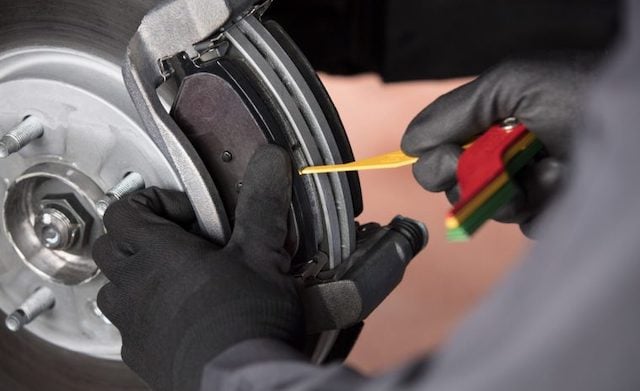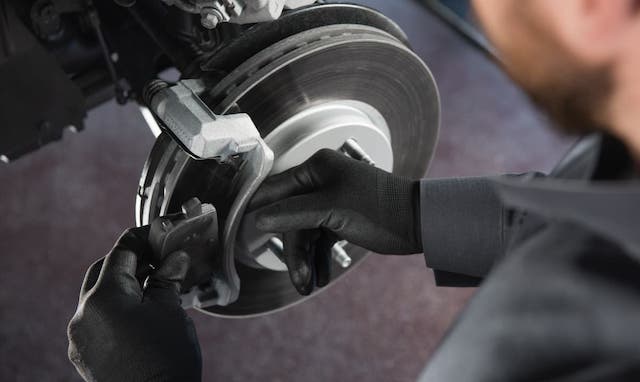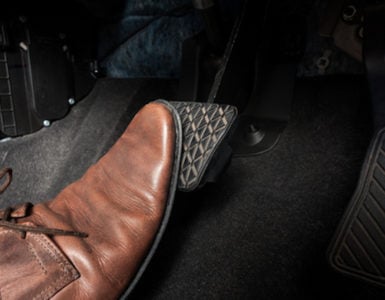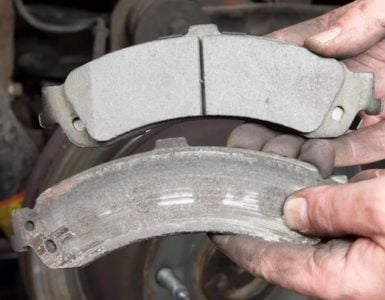When should you replace your brake pads? It’s a question many drivers ask, but few know the answer. As a car owner, it’s important to keep an eye out for the signs of failing brake pads and replace them ASAP. This way, your vehicle’s braking performance remains safe and reliable.
How Long Do Brake Pads Last?

A set of brake pads should last between 20K-65K miles. That’s a wide range. It’s because there are several different factors that determine the longevity of brake pads:
1. How Often And How Hard You Brake
Your driving habits determine when brake pads need replacing more than anything else. There are several situations that accelerate brake pad wear:
- Generally, drivers who spend a lot of time in stop-and-go traffic will replace their brake pads more often than those who don’t.
- Drivers who tow often will see increased brake pad wear.
- Heavier vehicles will cause faster wear of brake pads than lighter vehicles.
- Spirited driving
2. The Type And Quality Of The Brake Pad Friction Material
There are primarily three different types of brake pad friction material:
- Ceramic brake pads
- Organic brake pads
- Metallic brake pads
As a general rule of thumb, ceramic brake pads last the longest, followed by metallic brake pads. Out of these three types of brake pads, organic pads last the shortest amount of time.
This is because ceramic brake pads have the hardest friction material formulation. Organic brake pads have the softest formulation. Metallic pads fall between those two.
Material quality is another big factor that determines how long your brake pads will last. It’s possible for a high quality set of organic brake pads to last longer than a low quality set of ceramic brake pads.
Higher-grade (and often times higher-priced) brakes tend to last longer than lower-quality ones. Yet, better quality does not necessarily mean they’ll last longer. In fact, it’s possible for mid and low-range brake pads to outlast premium sets of brake pads. Some expensive pads are developed for high performance braking and produce great results. But the pad formulation can wear faster than less expensive pads.
So it can be hard to guess how long your brake pads will last. Brake pads don’t come with an expiration date or mileage warning. So drivers have to rely on visual signs to determine whether their brake pads need replacing. When you start to notice certain signs while driving, it’s a clear sign that the brake pads have worn down too much.
Telltale Signs That Your Brake Pads Have Worn Down

A few signs your brake pads need attention include:
- Squealing or grinding noises while braking
- Excessive brake pedal vibration while braking
- Longer stopping distances
- The nose of your vehicle pulling to one side while braking
- Brake pad indicator light coming on (in some cars)
If you hear squealing or grinding, you need to replace the brake pads ASAP. Grinding is the sound of metal-on-metal contact. This means that parts of your brake pad have worn completely away, and the steel backing plate is making contact with the rotor. If this continues long enough, there’s a chance that your rotor could be damaged beyond repair. You would have no choice but to replace your rotor(s) along with your brake pads.
Finding Out How Much Friction Material Your Pads Have Left

The best way to find out if your brake pads still have some life left is to measure the amount of friction material they still have.
Brake pad manufacturers provide a minimum thickness for your brake pads. If your brake pads wear down below the minimum thickness, you risk your car’s brake effectiveness and overall safety. If you can’t find a minimum thickness, many manufacturers state 3mm (1/8″).
To measure the thickness of your current brake pads, you need one of these tools:
- A brake pad thickness gauge
- A micrometer
- A vernier caliper
If you don’t have any of those tools on you, try using an ordinary ruler that has 0.001 inch graduations marked on it.
To check your brake pads, find out the minimum thickness from the manufacturer. Next:
- Lift your vehicle
- Remove one of the tires
- Measure the brake pads. Most modern calipers are designed so you can see the pad thickness through caliper.
- Repeat with the rest of the pads on your car
Need To Replace Your Brake Pads?

If your brake pads need replacing, be sure to order high quality brake pads. They’ll last longer. At BuyBrakes.com, we only carry the highest quality brake pads on the market.
We carry brand name ceramic, metallic and organic brake pads. All our brake pads come with warranties that protect you from defects in workmanship and materials. Check out our catalog of quality brake pads and order some today!



